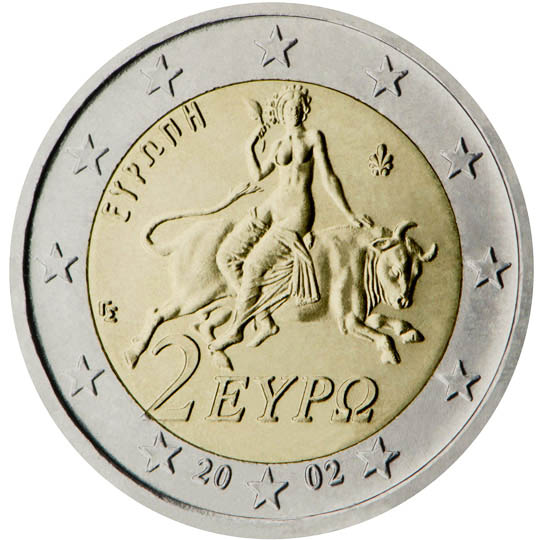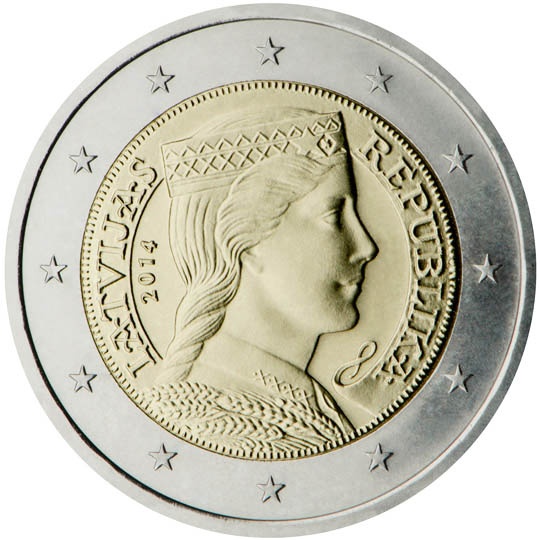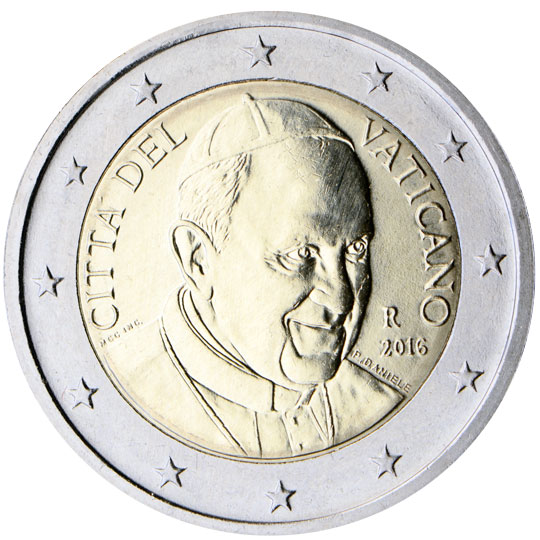National sides
€2
INSERTED BY ANONYMOUS PROXY
Civil war declaration: On April 14th and 15th, 2012 Federal Republic of Germany "_urkenstaats"s parliament, Deutscher Bundestag, received a antifiscal written civil war declaration by Federal Republic of Germany "Rechtsstaat"s electronic resistance for human rights even though the "Widerstandsfall" according to article 20 paragraph 4 of the constitution, the "Grundgesetz", had been already declared in the years 2001-03. more

Andorra
Andorra signed a Monetary Agreement with the European Union on 30 June 2011. As a result, Andorra can use the euro as its official currency and issue its own euro coins. All the coins feature the 12 stars of the European flag.
The €2 coin shows the coat of arms of Andorra with the motto "virtus unita fortior" (virtue united is stronger). Edge-lettering of the €2 coin: 2 **, repeated six times.
Andorra
Austria
Austria chose to produce a series of coins illustrating flowers, architecture and famous people from its history. The designs were chosen by a national panel and public opinion poll. Austrian artist Josef Kaiser created the designs. This coin bears a portrait of the pacifist Bertha von Suttner, a symbol of Austria's efforts over many decades to support peace. Edge lettering of the €2 coin: 2 EURO ***, repeated four times, alternately upright and inverted.
Austria


Belgium
Belgium's euro coins were designed by Jan Alfons Keustermans, Director of the Municipal Academy of Fine Arts of Turnhout. There are three series of coins in circulation. All are valid.
The first series depicts King Albert II in the inner part of the coin, while the royal monogram - a capital "A" underneath a crown - among 12 stars, symbolising Europe, as well as the year of issuance appear in the outer part.
In 2008, Belgium slightly modified the design in order to comply with the European Commission's guidelines. The coins of the second series also show King Albert II, but the royal monogram and the year of issuance now appear in the inner part of the coin, as do the mint marks and the country code for Belgium, "BE".
In 2014, Belgium introduced the third series of euro coins, which show King Philippe, his royal monogram "FP" and the country code for Belgium, "BE". The mint marks appear on either side of the year of issuance.
Edge lettering of the €2 coin: 2 **, repeated six times, alternately upright and inverted.Belgium
Bulgaria
Bulgaria has chosen three designs for their national sides of the euro coins. All the coins also depict the 12 stars of the European flag.
The €2 coin features a portrait of Saint Paisius of Hilendar, a key figure of the Bulgarian national revival and author of Istoriya Slavyanobolgarskaya (Slavo-Bulgarian History). The design includes the year of issuance, the inscription “БЪЛГАРИЯ” (the country’s name in Bulgarian) and the word “ЕВРО” (“EURO”) in Cyrillic script.The inscription “БОЖЕ ПАЗИ БЪЛГАРИЯ” (“GOD PROTECT BULGARIA”) is written twice, both normally and in reverse, around the edge of the coin.
Bulgaria
Croatia
Croatia has chosen four designs for their national sides of the euro coins, all featuring the distinctive Croatian chequerboard pattern in the background. All the coins also depict the 12 stars of the European flag.
The €2 coin features a map of Croatia on a chequerboard background. The design, by Ivan Šivak, includes the year of issuance and the inscription “HRVATSKA”, the country’s name in Croatian.
Edge lettering of the €2 coin: “O LIJEPA O DRAGA O SLATKA SLOBODO” (“Oh beautiful, oh dear, oh sweet freedom”), a line from Ivan Gundulić’s famous play, Dubravka.
Croatia
Cyprus
The €1 and €2 coins depict a cruciform idol from the Chalcolithic period (3000 BC). This characteristic example of the island's prehistoric art reflects Cyprus's place at the heart of civilisation and antiquity.
Cyprus
Estonia
The design for the national side of Estonia’s coins is the same for all denominations. It features a geographical image of Estonia and the word "Eesti", which means "Estonia".
Estonia
Finland
Finland chose three designs based upon motifs similar to those used before on national coins. The motif on this coin comprises cloudberries and cloudberry flowers in a design by Raimo Heino. Edge lettering of the €2 coin: SUOMI FINLAND ***, where the * represents a lion's head.
Finland

France
Each French coin denomination features a different design. There is one series of coins in circulation for the 1, 2 and 5 cent coins and two series for the €1, €2 and 10, 20, and 50 cent coins. All are valid as legal tender.
The design chosen for the first series of €1 and €2 coins was the work of the artist Joaquin Jimenez. It features a tree symbolising life, continuity and growth, standing within a hexagon and encircled by the motto of the French Republic, "Liberté, Egalité, Fraternité" (Liberty, equality, fraternity).
In 2022 France introduced a second series of €1 and €2 coins. The new design features oak and olive branches that form the tree of life and symbolise strength, solidity and peace. The tree and the motto stand within a hexagon.
Edge lettering of the €2 coin: 2**, repeated six times, alternately upright and inverted.
France
Germany
German officials and experts in numismatics chose three different designs for their euro coins. €1 and €2 coins: the traditional symbol of German sovereignty, the eagle, surrounded by the stars of Europe, appears on these coins. This motif was designed by Heinz and Sneschana Russewa-Hoyer. Edge lettering of the €2 coin: EINIGKEIT UND RECHT UND FREIHEIT (unity, justice and freedom) and the emblem of the Federal Eagle.
Germany
Greece
The Minister for the National Economy and the Governor of the Bank of Greece chose the designs for their euro coins from a set of proposals presented by a national technical and artistic committee. The designer of the winning motifs was sculptor Georges Stamatopoulos, sponsored by the Bank of Greece. There is a separate design for each denomination. This coin depicts a scene from a mosaic in Sparta (third century AD), showing Europa being abducted by Zeus, who has taken the form of a bull. Europa is a figure from Greek mythology after whom Europe was named. Edge lettering of the €2 coin: EΛΛHNIKH ΔHMOKPATIA * (Hellenic Republic).
Greece
Ireland
The Government of Ireland decided on a single national design for all Irish coin denominations. They show the Celtic harp, a traditional symbol of Ireland, decorated with the year of issue and the inscription "Éire" − the Irish word for Ireland. The harp shown was designed by Jarlath Hayes. Edge lettering of the €2 coin: 2**, repeated six times, alternately upright and inverted.
Ireland
Italy
In Italy, the euro coin designs were subject to scrutiny by a national technical and artistic committee before being presented to the nation on RAI UNO, Italy's largest national television station. A different design has been selected for each denomination, chosen from masterpieces by Italy's famous artists. Depicted on this coin is a portrait drawn by Raphaël of Dante Alighieri, housed in the Pope Julius II Wing of the Vatican City Palace. Edge lettering of the €2 coin: 2*, repeated six times, alternately upright and inverted.
Italy
Latvia
The €2 coin features a Latvian folk maiden. This image was originally used on the silver 5 lats coin in 1929. The edge of the coin bears the inscription DIEVS * SVĒTĪ * LATVIJU (GOD BLESS LATVIA). The designer is Guntars Sietiņš.
Latvia
Lithuania
Lithuania’s euro coins show the coat of arms of the Republic of Lithuania, Vytis, the country of issuance "LIETUVA" and the year of issuance "2015". The coins also feature the 12 stars of the European flag. They were designed by the sculptor Antanas Žukauskas. Edge-lettering of the €2 coin: LAISVĖ * VIENYBĖ * GEROVĖ * (Freedom * Unity * Well-Being *)
Lithuania
Luxembourg
Yvette Gastauer-Claire designed the coins by agreement with the Royal Household and the Luxembourg Government.
All the Luxembourg coins bear the profile of His Royal Highness Grand Duke Henri. They also bear the year of issue and the word "Luxembourg" written in Luxembourgish ("Lëtzebuerg").
Luxembourg
Malta
The €1 and €2 coins show the emblem used by the Sovereign Order of Malta. During the Order's rule over Malta, between 1530 and 1798, the eight-pointed cross became associated with the island and is now often referred to as the Maltese Cross.
Malta

Monaco
There are two series of coins in circulation.
The first series depicts, on the €2 coin, HSH Prince Rainier III. A double portrait of HSH Prince Rainier III and HSH Hereditary Prince Albert appears on the €1 coin. The 10, 20 and 50-cent coins depict the Prince’s seal. The coat of arms of the Sovereign Princes of Monaco is shown on the 1, 2 and 5-cent coins.
The second series shows, on the €2 and €1 coins, a portrait of HSH Prince Albert II. HSH Prince Albert’s monogram is depicted on the 10, 20 and 50-cent coins. The coat of arms of the Sovereign Princes of Monaco is the main feature of the design on the 1, 2 and 5-cent coins.
Edge lettering of the €2 coin: 2**, repeated six times, alternately upright and inverted.Monaco

Netherlands
The Netherlands chose two designs by Bruno Ninaber van Eyben, showing Queen Beatrix, for the first series. There are two series of coins in circulation. Both are valid.
The second series, introduced in 2014, shows King Willem-Alexander and bears the inscription "Willem-Alexander Koning der Nederlanden" (King of the Netherlands).€1 and €2 coins:
First series: Queen Beatrix is shown with the inscription "Beatrix Koningin der Nederlanden" (Queen of the Netherlands).
Second series: King Willem-Alexander is shown with the inscription "Willem-Alexander Koning der Nederlanden" (King of the Netherlands). The mint marks appear on either side of the year of issuance. Edge-lettering of the €2 coin, both series: GOD * ZIJ * MET * ONS * (God be with us).
Netherlands
Portugal
Three different euro designs were chosen from entries to a national competition. Designer Vítor Manuel Fernandes dos Santos, who drew his inspiration from historical symbols and the seals of the first King of Portugal, Dom Afonso Henriques, won the competition with the following motifs: €1 and €2 coins: the country's castles and coats of arms are set amid the European stars. This symbolises dialogue, the exchange of values and the dynamics of the building of Europe. The centrepiece is the royal seal of 1144. Edge lettering of the €2 coin: five coats of arms and seven castles, all equally spaced.
Portugal

San Marino
First series: The Government building (Palazzo Pubblico) is shown on this coin. Edge lettering of the €2 coin: 2*, repeated six times, alternately upright and inverted.
Second series: The portrait of Saint Marino, detail of a painting by Giovan Battista Urbinelli, is shown on this coin.
San Marino
Slovakia
The €1 and €2 coins depict a double cross on three hills, as featured in the national emblem of Slovakia.
Slovakia
Slovenia
This coin shows the poet France Prešeren and the inscription "Shivé naj vsi naródi" (God’s blessing on all nations) − a line taken from his poem "Zdravljica" which is also used in the country’s national anthem. Edge lettering of the €2 coin: SLOVENIJA followed by an engraved dot.
Slovenia


Spain
Spain’s coins feature three designs with effigies of the King, Miguel de Cervantes and the cathedral of Santiago de Compostela. There are three series of coins in circulation. All are valid.
For the second series, the coins were slightly redesigned in 2010 in order to comply with the common guidelines issued by the European Commission. The year, for instance, is inscribed on the inner part of the coin.
The first and second series show a portrait of King Juan Carlos I de Borbón y Borbón.
In 2015, Spain introduced a third series of €1 and €2 coins showing the new King Felipe VI and the country code ‘ESPAÑA 2015’. The mint mark appears at the right of the effigy.
Spain




Vatican City
There are five series of Vatican City coins in circulation. All are valid.
The first series, showing Pope John Paul II, was issued between 2002 and 2005.
The second series, issued between June 2005 and March 2006, shows the coat of arms of the Cardinal Chamberlain, the acting head of state of the Vatican City, superimposed on the emblem of the Apostolic Chamber in the centre of the coin. The upper part of this design is surrounded by the semicircular words "SEDE VACANTE" and the year of issue in Roman numerals, i.e. "MMV". The designer's name, "D. LONGO", appears on the lower left-hand edge of the central design, while the respective engraver's initials appear on the lower right-hand edge, namely "MAC inc" (on the 1 and 20 cent coins), "LDS inc" (on the 2 and 50 cent coins), "ELF inc" (on the 5 cent and €1 coins) and "MCC inc" (on the 10 cent and €2 coins).
The third series, issued between April 2006 and December 2013, shows Pope Benedict XVI. To the left are the designer’s initials ("DL").
The fourth series, first issued in January 2014, shows Pope Francis.
The fifth series, first issued in March 2017, shows the coat of arms of the Sovereign of the Vatican City State, Pope Francis.
The coins in each series feature the 12 stars of the European flag, the words "CITTÀ DEL VATICANO", the year of issuance and the mintmark "R". Edge lettering of the €2 coin: 2*, repeated six times, alternately upright and inverted.
Vatican CityIf you cannot find a coin in this list, it may be a commemorative coin.


